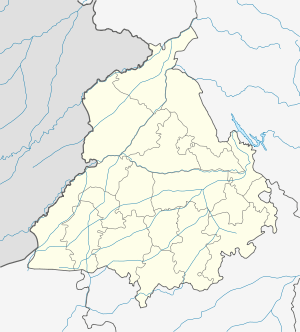Patti, Punjab
| Patti ਪੱਟੀ | |
|---|---|
| city | |
 Patti  Patti Location in Punjab, India | |
| Coordinates: 31°17′N 74°52′E / 31.28°N 74.86°ECoordinates: 31°17′N 74°52′E / 31.28°N 74.86°E | |
| Country |
|
| State | Punjab |
| District | Tarn Taran |
| Elevation | 209 m (686 ft) |
| Population (2001) | |
| • Total | 34,432 |
| Languages | |
| • Official | Punjabi |
| Time zone | IST (UTC+5:30) |
| Telephone code | 01851[area code] |
Patti is an old town and a municipal council of the Tarn Taran district in the Majha region of Indian state of Punjab, located 45 km from Amritsar. It is the main town on the border belt of India bordering Pakistan. It is connected through rail starting from Amritsar station to Khemkaran station, with Khemkaran being its last station of India.
Patti was a residence of Rai Duni Chand, a rich landlord, one of whose daughters, Bibi Rajni was a known devotee of Guru Ram Das Ji.[1] Mughal Governor of Punjab during Mughal period also lived in Patti. Before independence, Patti was a Tehsil of the Lahore district. The town houses the historic Mughal Fort and remains of the city wall. It also houses a number of other historical and religious places.
Etymology
Patti (Punjabi: ਪੱਟੀ) in Punjabi means street. The original name of this town was Patti Haibatpura, but over a certain period Patti became its name and stuck with it.[2] It was also known as 9 lakhi Patti, due to the wealth and revenue it generated during medieval days.
History
Before partition Patti was a tehsil of Lahore district. After bifurcation of Amritsar revenue district it becomes part of the newly created Tarn Taran district. Patti has been a power centre and by some estimates it has been so for as long as 1000 years. In the medieval days it was known as 9 lakhi Patti. That means it generated high revenue of 9 Lakhs. The town has stories of a certain haveli of its rulers Mirzas, which was destroyed to farming activity, as they migrated to Lahore (Pakistan) in 1947.[2]
The town is situated on a mound which adds to its altitude. To the south-east of the town is a smaller but higher mound which projects a Shiv Temple. Patti houses a fortress built in 1755 A.D. which housed the local police station up-till the year 2003.[2]
Patti finds rich references in the Sikh history especially when there were increased atrocities from declining mughals on Sikh Jatthedars (raiders) who looted the residents of the city. The fortress was used to prosecute rebellions. The tales of which became a part of everyday Sikh prayer.[2]
In the battle of misls, Patti was ultimately won by Faisailpuria(Singhpuria) Misl. Rumours suggest that Maharaja Ranjit Singh sent his army to siege the town when Mirza Talib Ali Baig rebelled against him for Sikh atrocities on Muslims, particularly banning of their call for prayer (Azan). During this siege, part of the outer wall was demolished.
Patti is also referenced as a place of the Pir (Sufism) and there were many houses of Pirs who belonged to Gillani's family.[2]
Institutions
Patti has many Government and Private educational institutions. Some of them are listed by
- Kalgidhar Academy Public School Khem Karan Road, Near Ware House, Tehsil Patti, Bhikhiwind Distt, Tarn Taran,
- Government Elementary School, Garden Colony, Patti,
- Government Elementary School, Kahiyan Wala Chowk, Patti,
- Government Girls Senior Secondary School, Patti,
- Government Boys Senior Secondary School, Patti
- Wood Blossom School, Garden Colony, Patti Wood Blossom School
- Sh. G. M Arya Sen.Sec. School for Girls, Patti
- Mahavir Jain Model School
- D.A.V Sen.Sec.School, Patti
- Shri Guru Harkrishan Public School
- Dashmesh Public School
- Central Convent Senior Secondary School, Patti(C.B.S.E Affiliated)
- St. Farid Public School, Sarhali Road, Patti.
- Shaheed Bhagat Singh High School
- Government College, Patti
- Shaheed Bhagat Singh College of Pharmacy, Patti,
- Shaheed Bhagat Singh College of Education, Kairon Road, Patti,
- Shaheed Bhagat Singh Polytechnic College, Patti,
- Shiv Shankar Institute of Engineering and Technology, Patti,
- Government Elementary School, ward No.2, Patti
- Futech Computer Education Centre, Near Punjab&Sind bank,patti
- Sacred Heart Convent School, Thakkarpura, Patti,
S.U.S. Convent School, Sarhali Road Patti
Demographics
As of 2001 India census,[3] Patti had a population of 34,432. Males constitute 53% of the population and females 47%. Patti has an average literacy rate of 65%, higher than the national average of 59.5%: male literacy is 70%, and female literacy is 60%. In Patti, 12% of the population is under 6 years of age.
References
- ↑ The Golden Temple Amritsar official site. http://www.goldentempleamritsar.org/places-to-visit-in-golden-temple-amritsar/dukh-bhanjani-beri.php
- 1 2 3 4 5 Patti from kartarpur.com
- ↑ "Census of India 2001: Data from the 2001 Census, including cities, villages and towns (Provisional)". Census Commission of India. Archived from the original on 2004-06-16. Retrieved 2008-11-01.